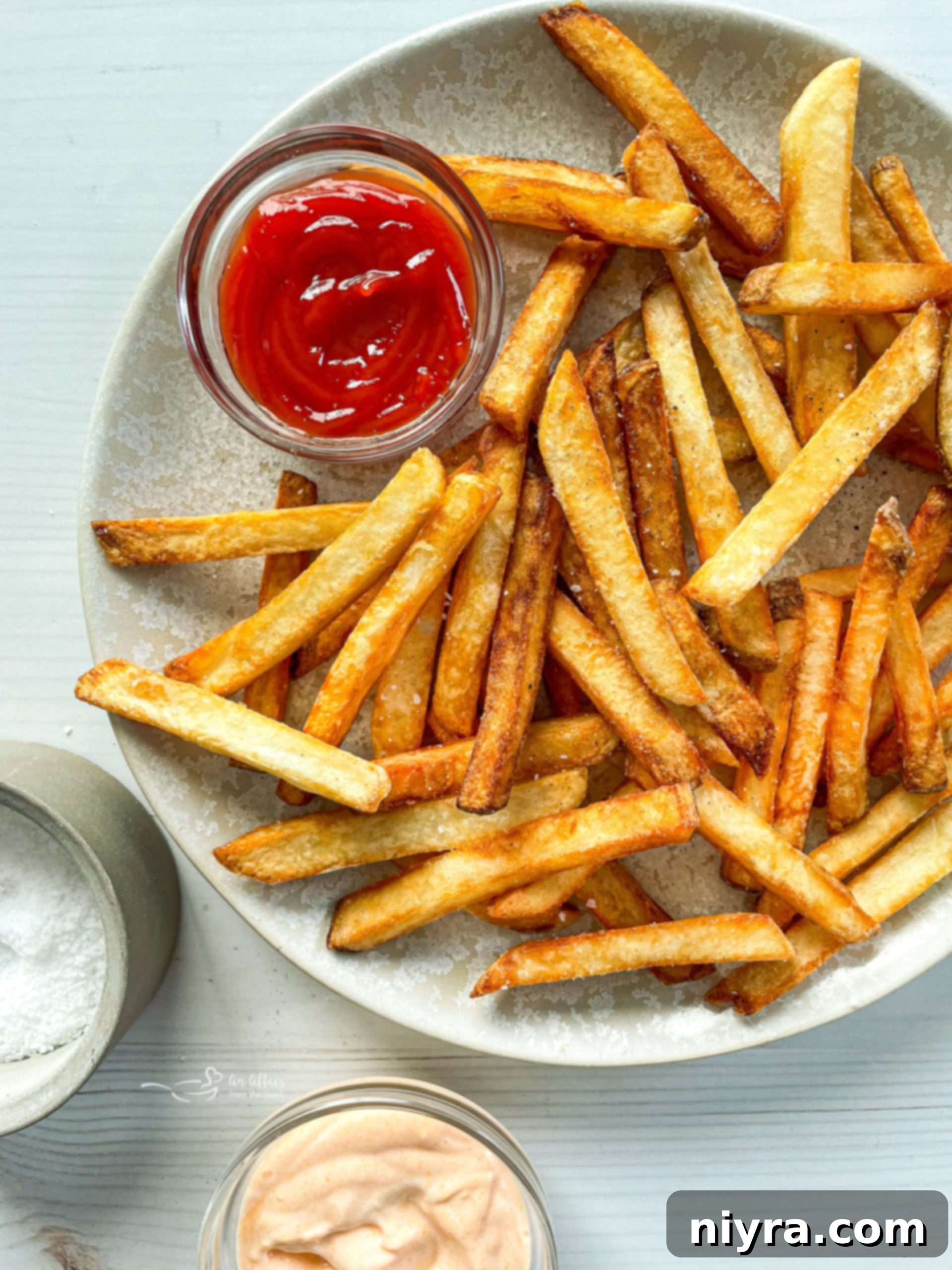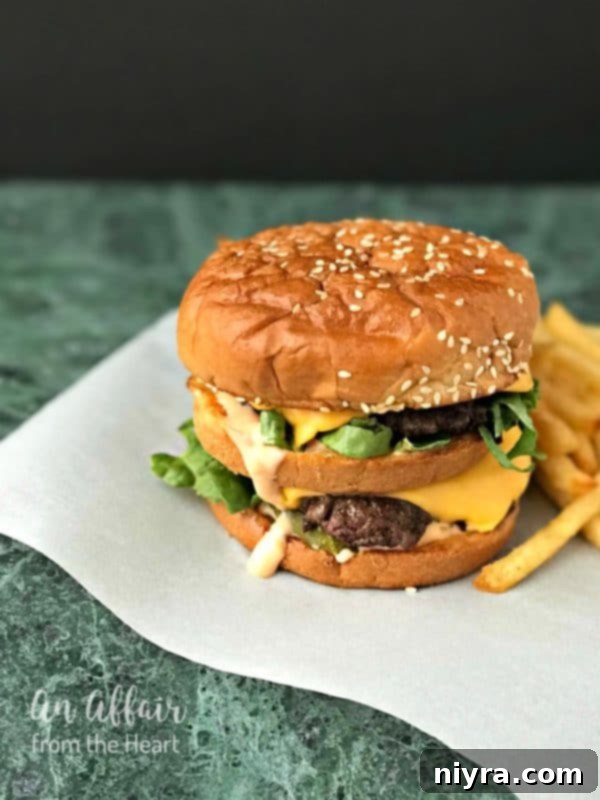The Ultimate Guide to Homemade Double-Fried French Fries: Achieving Restaurant-Quality Crispness at Home
Prepare yourself for an unparalleled culinary experience with this recipe for Homemade Double-Fried French Fries! Forget soggy, bland fries; these are engineered for maximum crispiness, a tender interior, and a savory flavor that will elevate any meal. Crafted with ease in mind, you can achieve these incredibly satisfying, golden-brown delights in under 30 minutes, bringing restaurant-quality taste right into your kitchen. A simple sprinkle of sea salt is all it takes to transform humble potatoes into a masterpiece of texture and flavor.
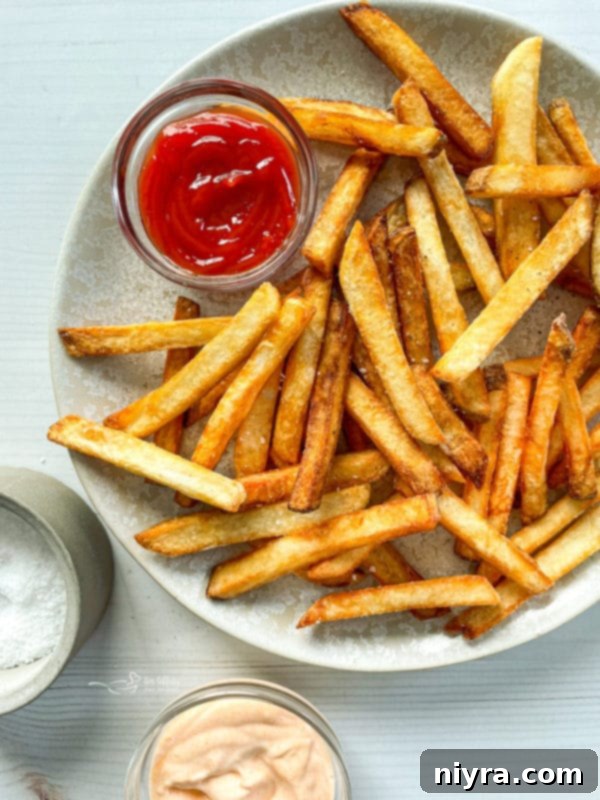
These magnificent homemade French fries, meticulously double-fried for optimal texture, are seasoned to perfection with just the right touch of savory sea salt. Each bite delivers an exquisite contrast: irresistibly crispy on the outside, yielding to a wonderfully soft and tender interior. If you’re searching for that quintessential homemade French fry experience, this recipe is guaranteed to impress, delivering consistent, delectable results every time.
Whether you prefer to enjoy these golden sticks with a classic dip like ketchup, smothered in rich cheese, topped with hearty chili, or paired with any other condiment that sparks joy, their superior crispiness remains a constant delight. This recipe is your answer to those intense cravings for authentic, restaurant-quality French fries, allowing you to recreate that beloved experience conveniently and affordably at home.
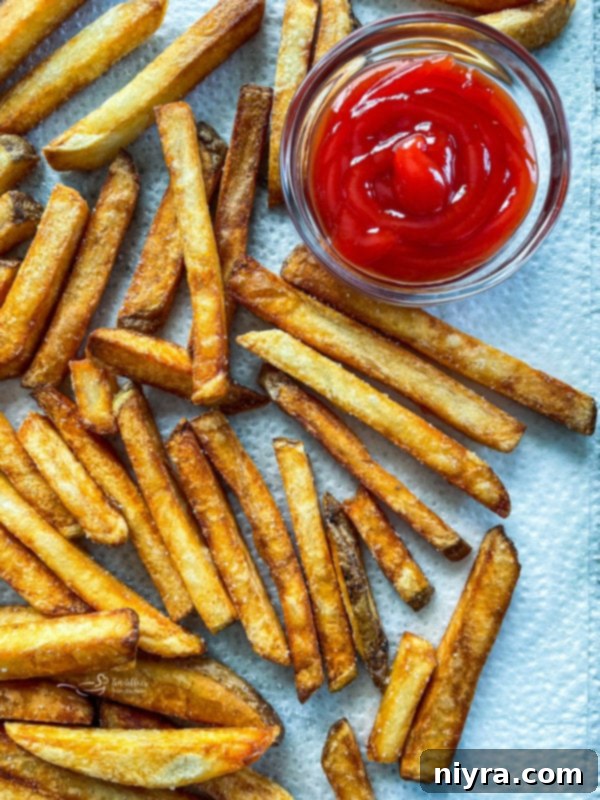
Why This Double-Fried French Fries Recipe Will Become Your Favorite
Discover the numerous reasons why this particular recipe stands out and is destined to become a staple in your culinary repertoire. From its simplicity to its incredible flavor, these fries offer something truly special.
- Effortlessly Easy: Don’t let the “double-fried” intimidate you; these fries are remarkably simple to prepare, requiring only a handful of common ingredients. The process is straightforward, making them a perfect, quick side dish or snack even on the busiest weeknights. Imagine serving a batch of fresh, homemade fries with minimal fuss—dinner just got a whole lot more exciting!
- Unforgettably Delicious: Moving beyond the convenience of frozen options, these fries boast a perfect harmony of textures—crispiness that gives way to a creamy, soft potato interior. Since they’re made from scratch using fresh, whole potatoes, you’ll savor authentic, comforting flavors that frozen varieties simply can’t match. Each bite is a testament to the simple perfection of real ingredients.
- Incredibly Versatile: The beauty of these fries lies in their adaptability. They serve as an ideal canvas for a myriad of toppings and dips. Experiment with rich melted cheddar or sharp Parmesan cheese, a sprinkle of your favorite seasoning blends, a drizzle of aromatic truffle oil, hearty chili, vibrant shakshuka, spicy buffalo chicken, or simply enjoy them on their own. And of course, the timeless combination of ketchup and fries remains an undefeated classic!
- Budget and Pantry-Friendly: This recipe is not only kind to your palate but also to your wallet. If you often find yourself with a few extra potatoes on hand, you’re halfway to creating these delectable fries. You only need a few basic pantry staples to get started, making it an incredibly economical choice for a satisfying homemade treat.
- Crowd-Pleasing Comfort Food: There’s something universally appealing about perfectly cooked French fries. This recipe consistently delivers that beloved comfort food experience, making it a guaranteed hit at family dinners, game nights, or casual gatherings. Prepare to receive rave reviews and requests for more!
A Nostalgic Journey: The Story Behind My Homemade Fries
My fondest childhood memories are steeped in the aroma of freshly fried potatoes, a tradition that began long before convenience foods dominated the market. We never reached for frozen French fries at my childhood home; my Mom was a purist, always making them from scratch. Her trusty “Veg-O-Matic” would slice the potatoes, and then they’d get their golden crisp in her beloved “Fry Daddy.” These were the French fries I grew up savoring, a taste of home that, in this fast-paced world, I admit I don’t recreate as often as I’d like.
Recently, my two older children, reminiscing about the “good old days” in our previous home, shared stories with their younger twin siblings about our tradition of making homemade French fries. It sparked a wonderful idea: it was high time to resurrect the Veg-O-Matic and dust off the Fry Daddy for a new generation to enjoy this delicious legacy.
The Legendary Veg-O-Matic
Have you ever encountered a Veg-O-Matic? For us, it was the cornerstone of our French fry making process. The routine was simple yet magical: peel and wash the potatoes, place one onto the blades, press down with a satisfying thud, and out came perfectly cut French fries from the bottom! As a child, it felt absolutely AMAZING—a genuine marvel in a time when cable television was a distant luxury.
The story of how I acquired my own Veg-O-Matic is a tender one, filled with both sadness and love. Contrary to what you might suspect, it wasn’t passed down from my mother.
A Legacy of True Love
In 1997, my husband’s paternal grandparents passed away on the very same day, mere hours apart. They were incredibly active individuals. His grandmother had just returned home from a game of golf when she discovered him peacefully in his favorite chair. The rescue squad arrived swiftly, transporting him to a hospital in a nearby town. We received the heartbreaking call, and my husband immediately rushed to be there. By the time he arrived, the news took another somber turn; his grandmother was also gravely ill, and a short while later, she too passed away. The doctors speculated she died of a broken heart, a testament to their profound connection. After 62 years of marriage, they were laid to rest side by side on the same day. Should anyone ever tell you that true love is merely a fairy tale, you can confidently tell them they never had the privilege of knowing Grandma and Grandpa Kenkel!
The Old-Fashioned French Fry Maker: A Treasured Find
During their estate sale, all their cherished belongings were meticulously arranged on flatbed trailers outside their home—decades of memories, boxed up and awaiting auction. As my husband and I wandered through the various boxes, a familiar shape peeked out from the bottom of one: a Veg-O-Matic! I knew instantly I had to have it. We purchased that entire box of miscellaneous items, and to this day, that very French fry maker holds a special place in my cupboard, a tangible link to a beautiful love story and a culinary heritage.
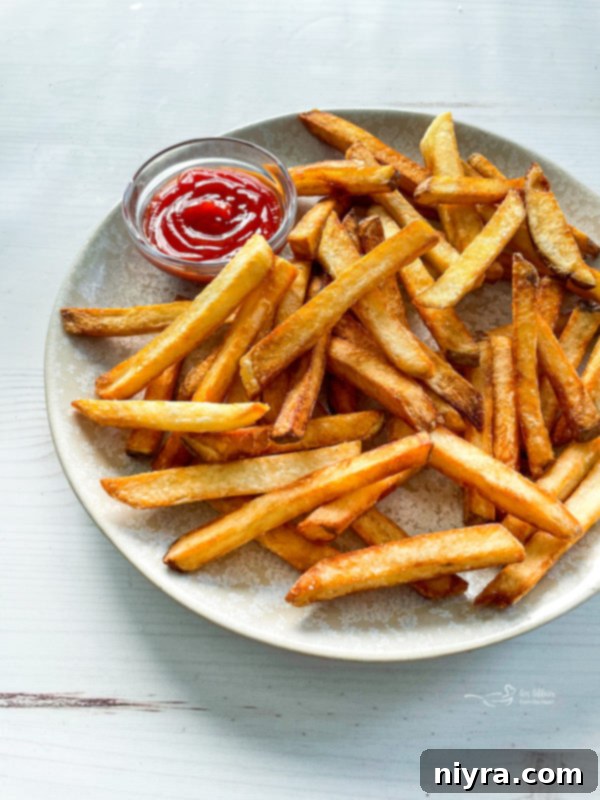
Selecting the Best Potatoes for French Fries
The foundation of an exceptional French fry is the potato itself. The choice of potato significantly impacts the final texture and flavor. While many varieties exist, certain types are superior for achieving that desired crisp exterior and fluffy interior.
Typically, Russet potatoes are the preferred choice for homemade French fries, and for good reason. Their unique composition—incredibly low in moisture but remarkably high in starch content—makes them ideal. High starch content is crucial because it promotes a drier, more open texture when fried, resulting in fries that are wonderfully crispy and less prone to sogginess. Nobody enjoys a limp fry!
While Russet potatoes should be your primary option, Yukon Gold potatoes also make an excellent alternative. These waxy potatoes possess a naturally buttery flavor and a creamier texture, which can add a delightful richness to your fries. Although slightly higher in moisture than Russets, their lower sugar content still allows for a beautiful golden-brown crisp.
To Peel or Not to Peel: Skins On or Off?
This is often a matter of personal preference. I personally lean towards peeling the skins off my potatoes for a more uniform texture, but many people thoroughly enjoy the rustic charm and added flavor that potato skins provide. If you opt to leave the potato skins on for your homemade fries, it is absolutely essential to meticulously scrub the potato skins clean with water and a firm brush to remove any dirt or impurities.
Portioning: How Many Potatoes Per Person for Homemade Fries?
When preparing a generous side of homemade French fries, a good rule of thumb is to allow for approximately four medium-sized whole potatoes per person. For a more precise measurement, especially if you have a kitchen scale, aim for about 6-7 ounces of potatoes per serving. This ensures everyone gets a satisfying portion of crispy goodness without overwhelming your deep fryer capacity per batch.
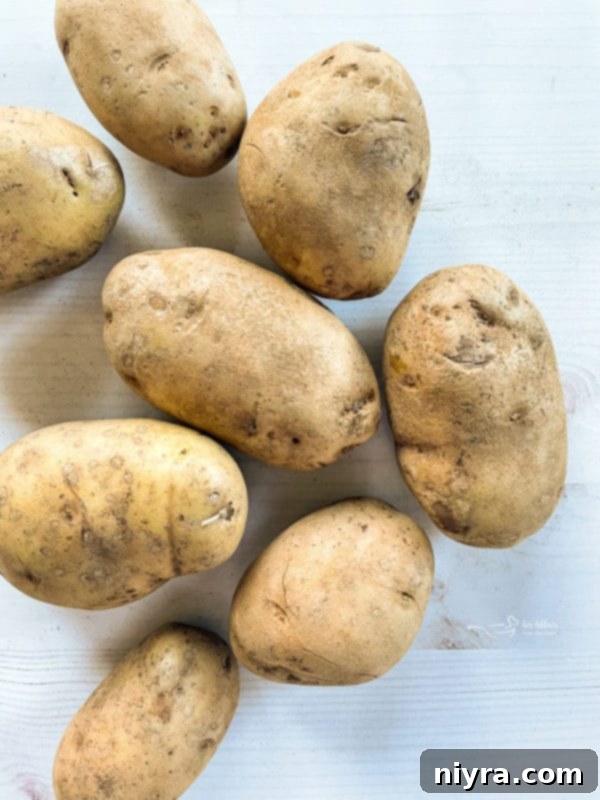
Essential Ingredients for Double-Fried French Fries
Crafting the perfect double-fried French fries requires just a few high-quality, simple ingredients. The magic lies not in complexity, but in the technique and the purity of these components.
Potatoes: As discussed, Russet potatoes are ideal for their high starch and low moisture content, yielding the crispiest results. Yukon Gold potatoes offer a delicious, slightly buttery alternative.
Oil: For deep frying these double-fried French fries, I typically use a neutral-flavored vegetable oil. However, a variety of oils are suitable, provided they have a high smoke point (above 350°F). Good options include canola, grapeseed, peanut, or safflower oil. Always ensure you have enough oil to submerge the fries adequately for even cooking.
Salt: A sprinkle of salt is crucial for enhancing flavor immediately after frying. I particularly love the subtle crunch and clean taste of sea salt for this recipe. You could also opt for kosher salt, Himalayan pink salt, or any other coarse salt you prefer. For those looking to add an extra dimension of flavor, consider trying a specialized French Fry Seasoning blend for an aromatic twist!
Preparing French Fries in Advance: Tips and Tricks
Yes, you can certainly prepare French fries ahead of time, which can be a real time-saver! Pre-cutting the potatoes allows for a crucial step: drawing out excess moisture and starch, contributing significantly to crispier fries. The key is to soak them properly in cold water immediately after cutting.
If you’re not planning to fry them right away, store the cut potatoes completely submerged in cold water in an airtight container in the refrigerator for up to 24 hours. For longer storage, you can blanch them (perform the first fry) and then freeze them.
Reheating Homemade French Fries for Optimal Crispness:
When it’s time to reheat your homemade French fries, for the best results, avoid the microwave. Instead, heat a thin layer of fresh oil in a large pan or skillet over medium-high heat. Once the oil is hot and shimmering, add the fries in a single layer and refry them, stirring and tossing occasionally, until they are evenly heated through and regain their desired crispness. This method reactivates the frying process, ensuring that perfect crunch. While microwaving is an option for speed, it often results in soggy fries, diminishing the overall experience.
Achieving Perfection: The Best Oil Temperature for French Fries
The secret to perfectly crispy and evenly cooked French fries lies in precise temperature control during the double-frying process. For the initial fry, or “blanching,” the ideal oil temperature is around 300°Fahrenheit (150°C). This lower temperature gently cooks the potato through, softening its interior without browning the exterior. If your oil isn’t hot enough during this stage, the fries will absorb too much oil and become greasy and soggy. Once you’re ready to double fry your fries for that ultimate crisp, you’ll need to significantly increase the oil temperature to 400°F (200°C). This higher temperature rapidly crisps the exterior, creating a golden crust and preventing further oil absorption.
Choosing the Best Oil for French Fries
The type of oil you use for frying is crucial for both flavor and safety. A high smoke point is essential to prevent the oil from breaking down and imparting off-flavors. While I used common vegetable oil for this recipe, there are several excellent options available. Oils like grapeseed, peanut, safflower, and canola are all fantastic choices. These oils typically have a smoke point well above 350°F (175°C), making them stable and safe for deep frying at the required temperatures. Avoid oils with lower smoke points, such as olive oil, as they will burn and produce an unpleasant taste.
Mastering the Art: How to Double Fry French Fries
Follow these detailed steps to create flawless homemade French fries that are crispy, tender, and bursting with flavor. This method is adaptable for both deep fryers and stovetop cooking in a heavy-bottomed pan.
For complete ingredient quantities and precise timing, please refer to the comprehensive recipe card located at the bottom of this page.
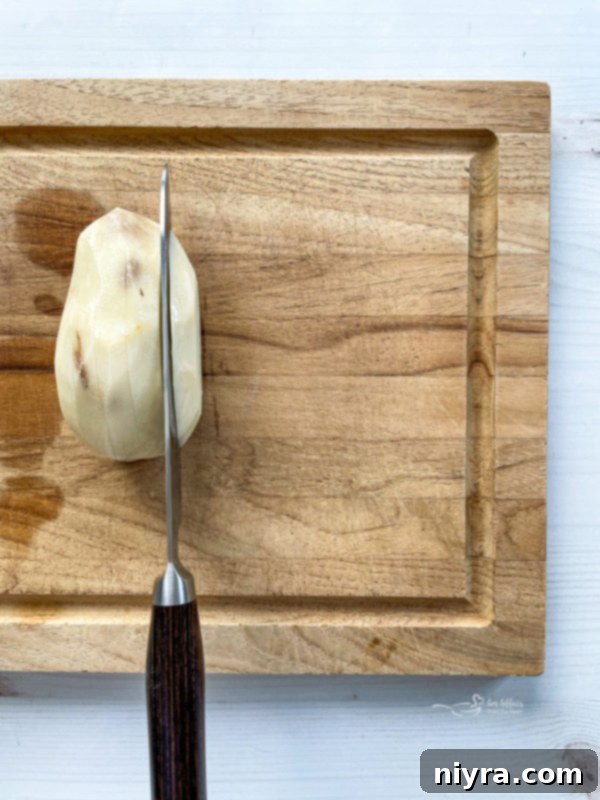
Step 1: Prepare the Potatoes. Begin by thoroughly peeling your potatoes and scrubbing away any dirt. While peeling is my preferred method for a smoother fry, you can absolutely leave the skins on for a more rustic feel. If opting for skins-on, ensure you clean the exterior exceptionally well with a brush under running water.
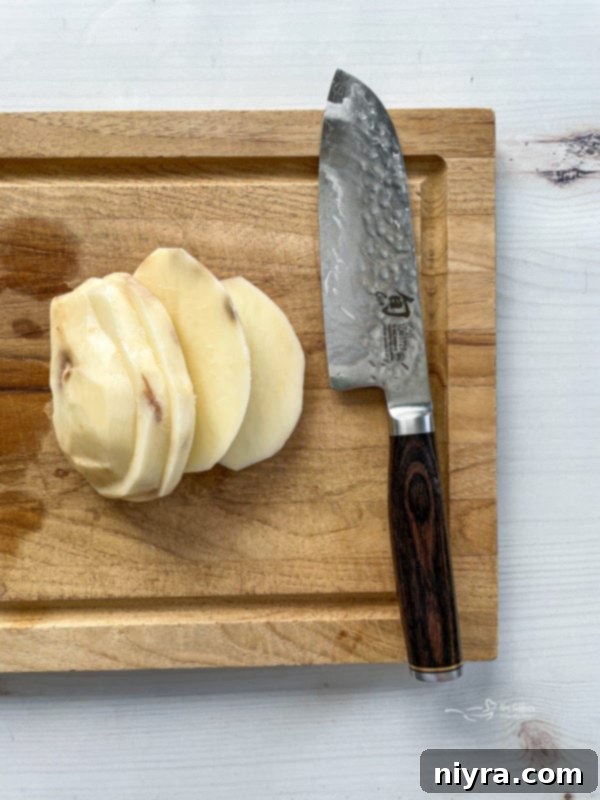
Step 2: Cut into Sticks. Next, take each potato and cut it lengthwise into four or five vertical pieces. From these pieces, carefully cut uniform sticks of your desired thickness. Consistency in size is key for even cooking. Alternatively, for a truly nostalgic and efficient approach, dust off that old Veg-O-Matic!
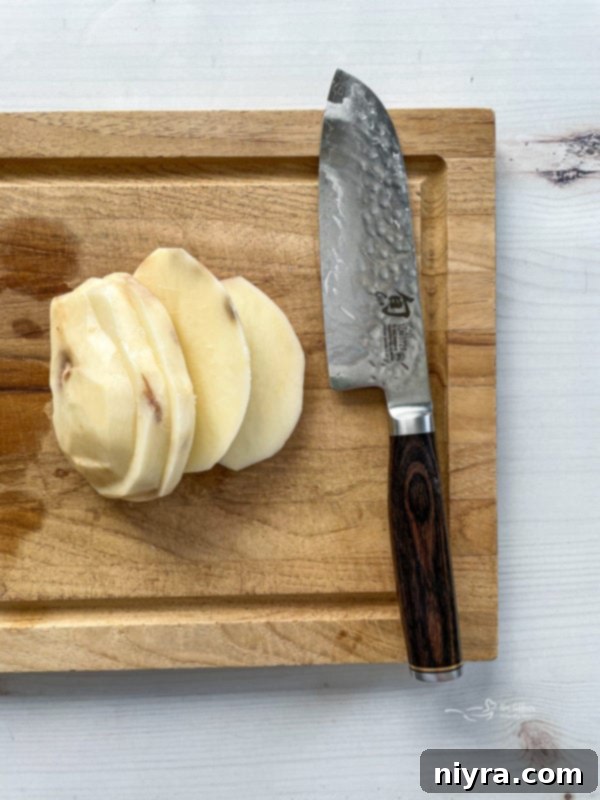
Step 3: The Essential Soak. Place the cut potato sticks into a large bowl and completely submerge them in cold water. Allow them to soak for at least 30 minutes, or ideally, several hours (up to overnight) in the refrigerator. This critical step removes excess starch, which is vital for achieving truly crispy fries and preventing them from sticking together.

Step 4: Dry Thoroughly. Before frying, drain the water completely from the potatoes. Then, spread the fries out on several layers of paper towels or a clean kitchen towel and blot them thoroughly until they are as dry as possible. This step is crucial for two reasons: dry potatoes fry crisper, and more importantly, water and hot oil are a dangerous combination, leading to splattering and potential burns.
Step 5: First Fry (Blanching). Fill your deep fryer (or a heavy-bottomed pot on the stovetop) with your chosen vegetable oil, ensuring it reaches the “fill line” or is about 3-4 inches deep. Heat the oil to 300°F (150°C). Working in small, manageable batches to avoid overcrowding, carefully fry the potatoes for approximately 5-7 minutes. At this stage, the potatoes should soften and become slightly translucent but should not begin to brown. Remove them from the fryer and spread them on a paper towel-lined baking sheet to drain and cool. This initial fry cooks the interior.
Step 6: Second Fry (Crisping). Once all the potatoes have completed their first fry and have cooled slightly, it’s time for the crisping stage. Increase the heat of your oil to 400°F (200°C). Return the blanched potatoes to the hot oil in small batches. Fry for another 3-5 minutes, or until they turn a beautiful golden brown and achieve their signature crispy exterior. Watch them closely during this stage, as they can go from perfectly golden to overcooked very quickly.
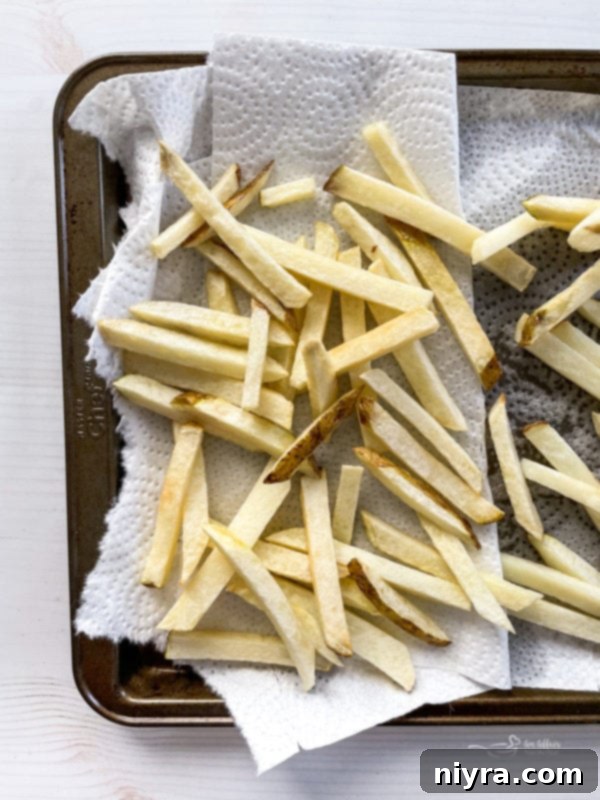
Step 7: Season and Serve. Immediately remove the golden, crispy fries from the oil and transfer them to a fresh paper towel-lined surface to drain any excess oil. While still hot, generously sprinkle them with sea salt to season. Serve these incredible double-fried French fries piping hot with your favorite dips or accompaniments!
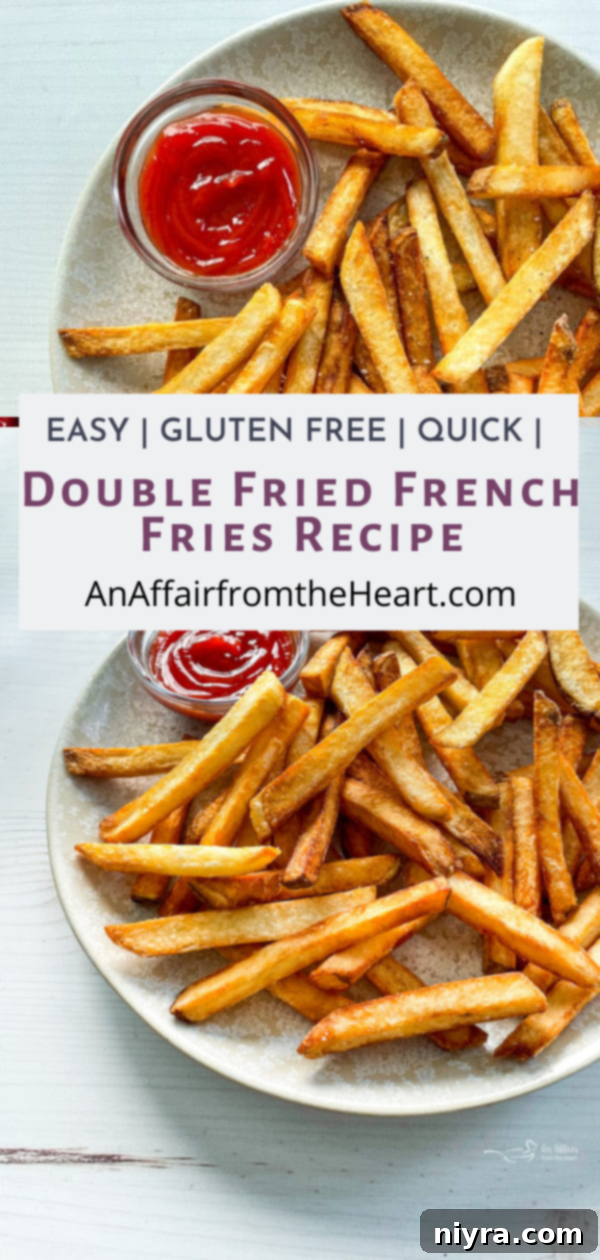
Love This Recipe? Pin It for Later!
Don’t let this incredible recipe for achieving perfectly crispy double-fried French fries slip away! Be sure to pin it to your favorite recipe board so you can easily find it whenever a craving strikes!
Frequently Asked Questions About French Fries
Here are answers to some common questions that will help you perfect your homemade French fries.
Is Soaking Potatoes Before Frying Truly Necessary?
Absolutely, soaking your cut potatoes before frying is a crucial step for achieving superior French fries. When you soak homemade fries in cold water, you are effectively drawing out excess starches and sugars from the potato cells. If you skip this vital step, the surface of the fries will remain overly starchy, leading to a gluey texture, uneven browning, and a tendency for the fries to stick together during frying. More importantly, excess starch can result in a soft, rather than crisp, exterior. Soaking also helps to prevent the fries from burning too quickly on the outside before the interior has cooked properly.
How Do I Achieve Consistently Crispy French Fries from Scratch?
To guarantee consistently crispy French fries, two fundamental steps are non-negotiable: properly soaking the potatoes and implementing the double-frying technique. Soaking removes the starches that cause sogginess, while double-frying ensures optimal texture. The first fry cooks the potato through at a lower temperature, and the second, hotter fry rapidly crisps the exterior, creating that delightful crunch without overcooking the inside. These two steps are the definitive keys to unlocking perfectly crispy French fries every single time!
What is the Advantage of Double-Frying Fries?
Double-frying French fries is not just a culinary embellishment; it’s a strategic technique that delivers vastly superior results. The first fry, performed at a lower temperature (around 300°F/150°C), cooks the potato flesh until it’s tender and fluffy on the inside. This “blanching” step also allows some moisture to escape, preparing the surface for maximum crispness. The second fry, conducted at a significantly higher temperature (around 400°F/200°C), rapidly crisps and browns the exterior, forming a perfect, golden crust. This two-stage process prevents the fries from becoming overly oily or soggy, ensuring they are crunchy on the outside and wonderfully soft on the inside. It truly gives them that desired “extra layer of fried goodness” that sets them apart from single-fried versions.

Freezing Double-Fried French Fries for Future Enjoyment
Freezing homemade French fries is an excellent way to prepare ahead or preserve leftovers, whether they are raw (blanched) or fully cooked. For freezing raw, blanched fries (after the first fry), it’s crucial to ensure they are completely dry and cool before proceeding. Lay them in a single layer on a baking sheet and freeze until solid, then transfer to an airtight freezer bag or container. This prevents them from clumping together. When ready to cook, fry them directly from frozen at 400°F (200°C) until golden and crispy.
If you’re freezing cooked French fries, allow them to cool completely after the second fry. Once cool, transfer them to an airtight freezer-safe storage container or heavy-duty freezer bag. To reheat, spread them on a baking sheet and bake at 400°F (200°C) until hot and re-crisped, or follow the stovetop reheating method mentioned earlier.

What to Serve with Your Perfect Homemade Fries
These double-fried French fries are versatile and complement a wide array of dishes. They’re the ultimate sidekick to classic American fare. Consider serving them alongside my hearty slow cooker buffalo pulled pork with celery slaw, a juicy and flavorful Juicy Lucy burger, or these savory blackened salmon burgers with BLT slaw. The possibilities are endless!
More Delicious Recipes You’ll Love
If you enjoyed these homemade French fries, you might also like these other comforting and flavorful recipes:
- Copycat McDonald’s Big Mac (pictured above, perfect with fries!)
- Grandma’s Classic Baked Beans
- Crispy Air Fryer BBQ Chicken Potato Skins
- Fragrant Garlic Rosemary Heirloom Potatoes
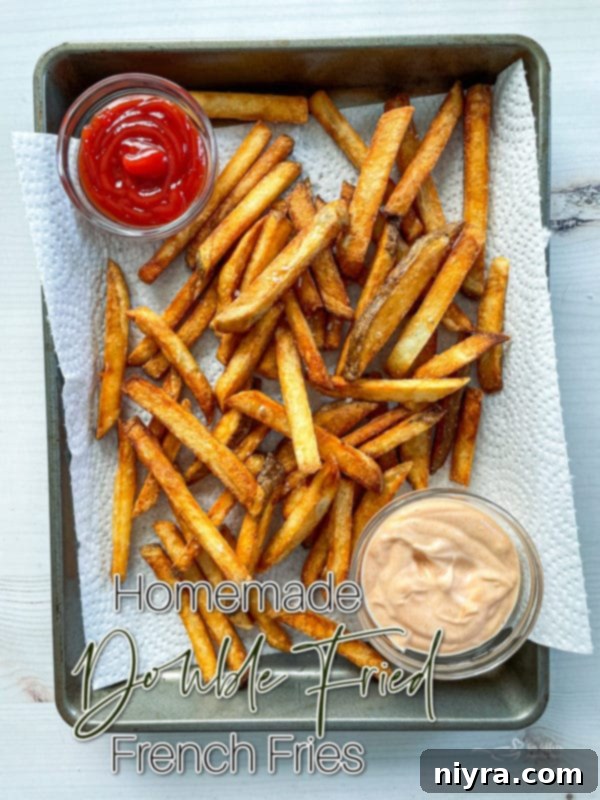
Ready to make some truly unforgettable Double-Fried French Fries? Let’s get cooking! 
LIKE THIS RECIPE?
Don’t forget to give it a ⭐️⭐️⭐️⭐️⭐️ star rating and
leave a comment below the recipe!

Print Recipe
Homemade {double fried} French Fries
10 minutes
15 minutes
25 minutes
American
Homemade {double fried} French Fries
8
servings
321
kcal
Michaela Kenkel
Ingredients
-
5
pounds
Russet Potatoes
peeled and sliced -
Vegetable Oil
for frying -
Sea Salt
for seasoning
Instructions
- Peel and scrub dirt from the potatoes. Alternatively, you can leave the skins on, just be sure to scrub them really well.
- Cut potatoes in four or five vertical pieces, and then cut each piece into sticks of your desired size. (or use that old Veg-o-Matic!)
- Place potatoes in a large bowl and completely cover them with cold water, then allow them to soak for at least three hours, you can also place them in the fridge and let them soak overnight.
- When it’s time to make the French fries, drain the water and blot any remaining water off with a paper towel. (Water can be dangerous when it hits hot oil!)
- Fill fryer to “fill line” with vegetable oil and heat to 300 degrees. In small batches, fry potatoes for about 5 minutes, potatoes should be soft but not brown! Remove them from fryer and lay them aside on a paper towel-lined baking dish.
- Once potatoes have been pre-fried, turn up the heat on your oil to 400 degrees. Fry the potatoes again until they are golden brown and crispy on the outside. This will take about 10 minutes. Watch them closely.
- Sprinkle fries with sea salt to season.
Notes
You can achieve the same outcome by frying the French fries on the stovetop in a heavy pan with oil.
Nutrition
Serving:
1
|
Calories:
321
kcal
|
Carbohydrates:
61
g
|
Protein:
7
g
|
Fat:
6
g
|
Polyunsaturated Fat:
5
g
|
Sodium:
160
mg
|
Fiber:
7
g
|
Sugar:
3
g
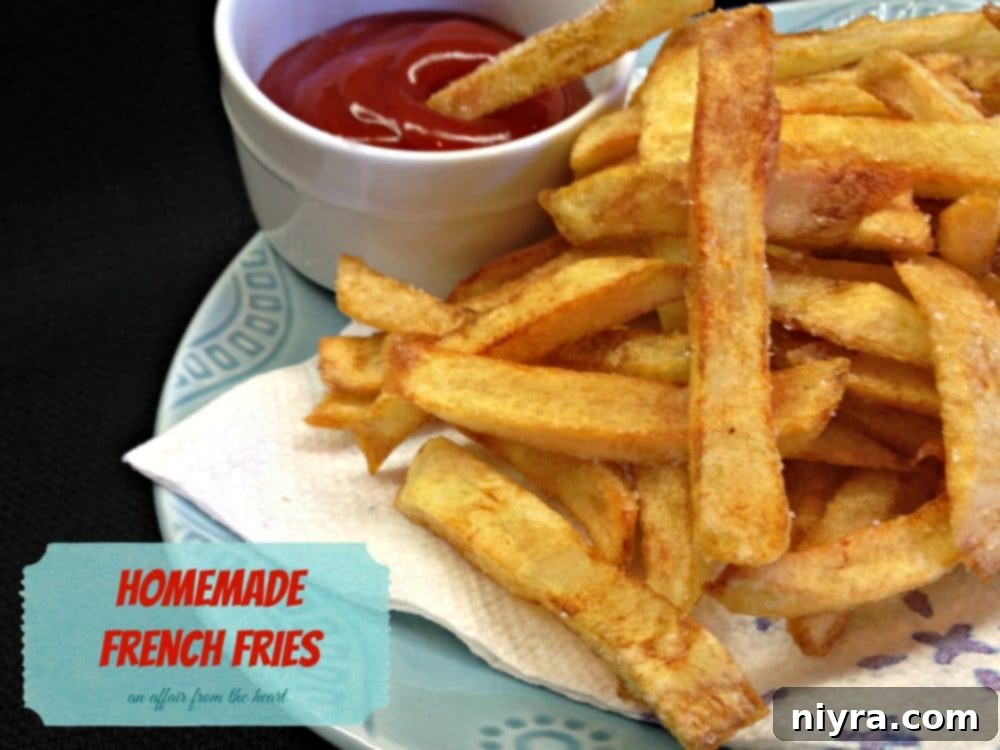
This timeless recipe was originally shared on June 2, 2014. It was thoughtfully updated to enhance user experience, improve clarity, and was proudly re-shared on April 7th, 2021.
